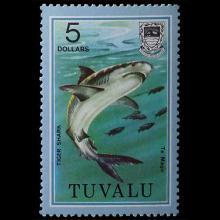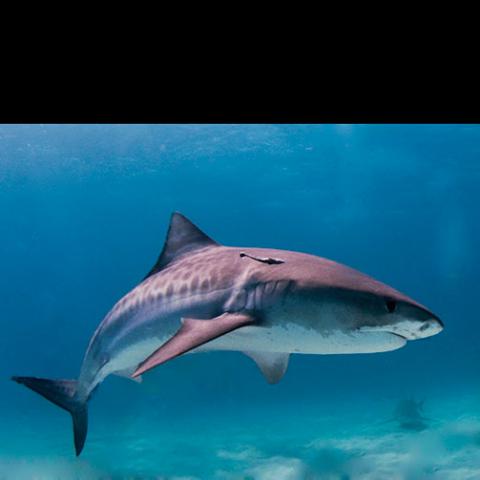NAMES
TAXONOMY
Mozambique
Issued:
Stamp:
Galeocerdo cuvier
Tuvalu
Issued:
Stamp:
Galeocerdo cuvier
Mozambique
Issued:
Stamp:
Galeocerdo cuvier
Tuvalu
Issued:
Stamp:
Galeocerdo cuvier
Mozambique
Issued:
Stamp:
Galeocerdo cuvier
Tuvalu
Issued:
Stamp:
Galeocerdo cuvier
This Man Has Been Best Friends with a 15-Foot Tiger Shark for Two Decades
Check out this great video and article about a tiger shark (Galeocerdo cuvier). It might change how you think about them.
Genus species (Animalia): Galeocerdo cuvier
The tiger shark (Galeocerdo cuvier) is a species of requiem shark and the only extant member of the genus Galeocerdo. It is a large macropredator, capable of attaining a length over 5 m (16 ft 5 in). Populations are found in many tropical and temperate waters, especially around central Pacific islands. Its name derives from the dark stripes down its body, which resemble a tiger's pattern, but fade as the shark matures.
The tiger shark is a solitary, mostly nocturnal hunter. It is notable for having the widest food spectrum of all sharks, with a range of prey that includes crustaceans, fish, seals, birds, squid, turtles, sea snakes, dolphins, and even other smaller sharks. It also has a reputation as a "garbage eater", consuming a variety of inedible, man-made objects that linger in its stomach. Though apex predators, tiger sharks are sometimes taken by groups of killer whales. It is considered a near threatened species due to finning and fishing by humans.
The tiger shark is second only to the great white in recorded fatal attacks on humans, but these events are still exceedingly rare.
Relationship with humans
Although sharks rarely bite humans, the tiger shark is reported to be responsible for a large share of fatal shark-bite incidents, and is regarded as one of the most dangerous shark species. They often visit shallow reefs, harbors, and canals, creating the potential for encounter with humans. The tiger shark also dwells in river mouths and other runoff-rich water. While the tiger shark is considered to be one of the sharks most dangerous to humans, its bite rate is low. It ranks second on the list of number of recorded bites on humans, behind only the great white shark. Typically, three to four shark bites occur per year in Hawaii, but they are rarely fatal; one notable survivor of such an attack is surfing champion Bethany Hamilton, who lost her left arm at age 13 to a tiger shark in 2003. This bite rate is very low, considering that thousands of people swim, surf, and dive in Hawaiian waters every day. Human interactions with tiger sharks in Hawaiian waters have been shown to increase between September and November, when tiger shark females are believed to migrate to the islands to give birth.
Between 1959 and 2000, 4,668 tiger sharks were culled in an effort to protect the tourism industry. Despite damaging the shark population, these efforts were shown to be ineffective in decreasing the number of interactions between humans and tiger sharks. Feeding sharks in Hawaii (except for traditional Hawaiian cultural or religious practices) is illegal, and interaction with them, such as cage diving, is discouraged. South African shark behaviorist and shark diver Mark Addison demonstrated divers could interact and dive with them outside of a shark cage in a 2007 Discovery Channel special, and underwater photographer Fiona Ayerst swam with them in the Bahamas. At "Tiger Beach" off Grand Bahama, uncaged diving with – and even the handling of – female tiger sharks has become a routine occurrence.
Reference: wikipedia



